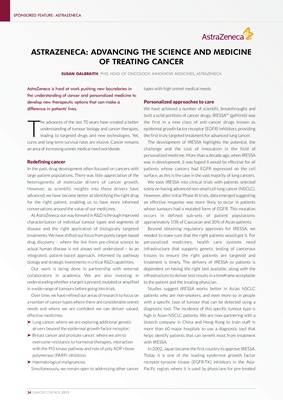
SPONSORED FEATURE: ASTRAZENECA
ASTRAZENECA: ADVANCING THE SCIENCE AND MEDICINE
OF TREATING CANCER
SUSAN GALBRAITH, PHD, HEAD OF ONCOLOGY, INNOVATIVE MEDICINES, ASTRAZENECA
AstraZeneca is hard at work pushing new boundaries in types with high unmet medical needs.
the understanding of cancer and personalized medicine to
develop new therapeutic options that can make a Personalized approaches to care
difference in patients' lives. We have achieved a number of scientific breakthroughs and
built a solid portfolio of cancer drugs. IRESSA™ (gefitinib) was
T
he advances of the last 70 years have created a better the first in a new class of anti-cancer drugs known as
understanding of tumour biology and cancer therapies, epidermal growth factor receptor (EGFR) inhibitors, providing
leading to targeted drugs and new technologies. Yet, the first truly targeted treatment for advanced lung cancer.
cures and long-term survival rates are elusive. Cancer remains The development of IRESSA highlights the potential, the
an area of increasing unmet medical need worldwide. challenge and the cost of innovation in the field of
personalized medicine. More than a decade ago, when IRESSA
Redefining cancer was in development, it was hoped it would be effective for all
In the past, drug development often focused on cancers with patients whose cancers had EGFR expressed on the cell
large patient populations. There was little appreciation of the surface, as this is the case in the vast majority of lung cancers.
heterogeneity of molecular drivers of cancer growth. We took IRESSA into clinical trials with patients selected
However, as scientific insights into these drivers have solely on having advanced non-small cell lung cancer (NSCLC).
advanced, we have become better at identifying the right drug However, after initial Phase III trials, data emerged suggesting
for the right patient, enabling us to have more informed an effective response was more likely to occur in patients
conversations around the value of our medicines. whose tumours had a mutated form of EGFR. This mutation
At AstraZeneca, our way forward in R&D is through improved occurs in defined sub-sets of patient populations:
characterization of individual tumour types and segments of approximately 10% of Caucasian and 30% of Asian patients.
disease and the right application of biologically targeted Beyond obtaining regulatory approvals for IRESSA, we
treatments. We have shifted our focus from purely target-based needed to make sure that the right patients would get it. For
drug discovery – where the link from pre-clinical science to personalized medicines, health care systems need
actual human disease is not always well understood – to an infrastructure that supports genetic testing of cancerous
integrated, patient-based approach, informed by pathway tissues to ensure the right patients are targeted and
biology and strategic investments in critical R&D capabilities. treatment is timely. The delivery of IRESSA to patients is
Our work is being done in partnership with external dependent on having the right test available, along with the
collaborators in academia. We are also investing in infrastructure to deliver test results in a timeframe acceptable
understanding whether a target is present, mutated or amplified to the patient and the treating physician.
in a wide range of tumours before going into trials. Studies suggest IRESSA works better in Asian NSCLC
Over time, we have refined our areas of research to focus on patients who are non-smokers, and even more so in people
a number of cancer types where there are considerable unmet with a specific type of tumour that can be detected using a
needs and where we are confident we can deliver valued, diagnostic tool. The incidence of this specific tumour type is
effective medicines: high in Asian NSCLC patients. We are now partnering with a
‰ Lung cancer, where we are exploring additional genetic biotech company in China and Hong Kong to train staff in
drivers beyond the epidermal growth factor receptor; more than 60 major hospitals to use a diagnostic tool that
‰ Breast cancer and prostate cancer, where we aim to helps identify patients that can benefit most from treatment
overcome resistance to hormonal therapies, interaction with IRESSA.
with the PI3 kinase pathway and role of poly ADP ribose In 2002, Japan became the first country to approve IRESSA.
polymerase (PARP) inhibition; Today it is one of the leading epidermal growth factor
‰ Haematological malignancies. receptor-tyrosine kinase (EGFR-TK) inhibitors in the Asia-
Simultaneously, we remain open to addressing other cancer Pacific region, where it is used by physicians for pre-treated
34 CANCER CONTROL 2013